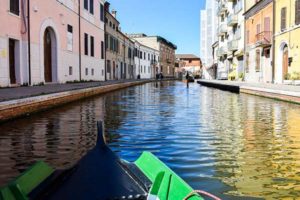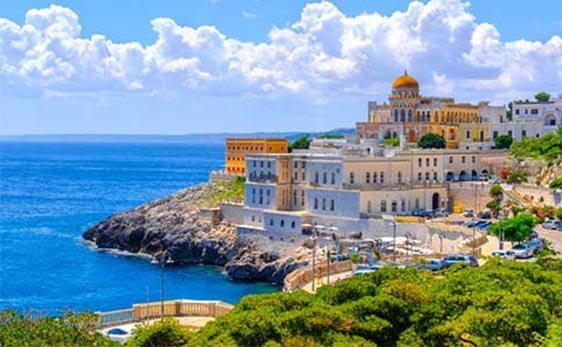Live "La Dolce Vita" in Sunny Italy
Italy has a staggering amount to offer travelers…and residents. Romantic cities, timeless hill towns, snowy mountains, idyllic islands, vineyard-covered countryside, and a rivetingly beautiful coastline. Plus, outside the major cities, homes start at a mere $50,000—or less.
Expats in Italy say they love not only the art, culture, impressive architecture, world-renowned food, and easy access to the rest of Europe, but also the slower pace of life and the culture that prioritizes family and friends over work and to-do lists.
This is the very definition of the sweet life. It’s about surrounding yourself with people you love, taking the time to enjoy even the simplest things—a delicate zucchini blossom, a well-made cup of coffee, the feeling of sand between your toes—and prioritizing the important things in life.
A Slower, Simpler Italian Way of Life
Retirees report that this cultural attitude means the pace of life is slower in Italy, especially outside the main cities. They talk about long coffee breaks with Italian friends and passeggiata (strolls) through the town in the evening. One couple says that they no longer have alarm clocks in their home. Another couple adds that happiness just seems more important to the Italians.
A Surprisingly Affordable Lifestyle
These same expats report that their simpler lives in Italy come with a lower price tag than they would have expected.
In lesser-known, beautiful countryside Le Marche, one couple says their expenses are 80% cheaper than their previous life in New York. In sunny southern Calabria, another expat says a cup of coffee costs just 90 cents, a multi-course meal runs about $34 per person, and health insurance for the entire year is covered by about $230. And in Umbria—Tuscany’s pretty neighbor—one of our correspondents spent less than $2,000 in living expenses per month.
The Italian Visas That Make a Move to Italy Possible
Life in Italy sounds pretty nice…so the next question most people have is: can I do it? Is it legally and logistically possible to make the move?
And the answer is yes.
Italy offers a variety of visas for non-Italians who would like to live in the country. The one most retirees apply for is the elective residence visa, which is designed for retirees and other people who do not need to take a job in Italy. For this, you’ll need proof of financial means, a rental agreement or deed in Italy, and proof of medical insurance that covers you there. The key to this visa is proving that you don’t need to work.
And if you have Italian ancestry, you may be in even better shape. If you have a parent, grandparent, or even great-grandparent born in Italy, you may be eligible for dual citizenship.
In other words, if you’re dreaming about a move to Italy, your dream just might be more possible than you ever imagined.
The Pros and Cons of Living in Italy
By Valerie Schneider
They say there are two sides to every story, and I think the same is true of places to live, as well. What attracts us may be anathema to someone else. When we moved to Italy 10 years ago, we came with the mentality that things aren’t better or worse, they’re just different. That thought helped us adapt to the lifestyle and culture in a smoother way, through the pros and cons of moving to a foreign land.
Through the lens of a decade abroad, here are the highs and lows of life in Italy.
Climate

While many people view Italy as a perpetually sunny and moderate Mediterranean climate, the truth is there are four seasons. That may be a pro or a con, depending on your viewpoint. Experiencing a change of season helps mark the rhythm of the Italian year.
Pros: Italy’s geography offers a variety of weather, from mild to harsh, depending on where you choose and what you prefer. The seas that surround the peninsula help keep the coastal areas moderate, so living close to the Mediterranean, for example, will give you less drastic fluctuations of temperature than the Alps. Those who like winter sports will rejoice at the many mountain areas in Italy, where snow piles up for skiing and snowshoeing.
Rome has a pleasant climate, even in winter, though you’ll still need a coat and umbrella. Temperature averages hover in the 50s F, though night variances drop by about 15 degrees. If you’re looking for the mildest weather possible, look to Sicily, Puglia, or the coastal Riviera of Liguria.
Cons: In the north, cold, wet, and foggy winters are the norm while summers tend to be hot and humid, especially along the Po River valley. Known for its sunshine, the south can bring hot, dry summers, but many people assume it is warm everywhere and miscalculate the mountainous areas, which are much cooler. Snow is not uncommon in the Apennines, even in the south.
Winter months bring the most rain, especially in November and December. The Adriatic regions can occasionally shiver under blasts from the Baltics.
Earthquakes. A few areas, like Abruzzo and Umbria, have been experiencing more activity in recent years. Check the geological maps when looking at property.
Cost of Living

Pros: The overall cost of living comes as a surprise to many expats, because it is about one-third (or in some cases half) the costs they’re used to. The exchange rate has remained favorable; certainly a far shot better than when we bought our home, when it spiked at more than $1.40 to the Euro. Famous cities always cost more everywhere in the world, but look outside those and the cost of living is moderate, even cheap. A couple can live comfortably on $2,200 a month (or less) depending on your lifestyle. Housing costs can vary widely, of course, but there are lots of bargains to be had all over Italy, even in art cities. If you go a half-hour or so from Rome or Florence, for example, you can still get a train in to enjoy the cultural amenities and city life, while basking in a hill town at half the price. In some small towns, houses cost less than a new car in the States.
Food and daily living costs are lower overall than in the U.S. and the healthcare system is a lot more affordable. Museums and airfare around Europe both present great opportunities for cultural outings and travel—both at relatively cheap prices.
Cell phone rates and internet cost less, with more options available. I pay just $14.50 a month for my cell plan that includes unlimited calls, texts, and more data than I ever use, along with 400 free international minutes every month. And I don’t have a contract, so I can change it without penalties if I find a better deal.
Cons: Utility costs can be high, and gasoline is exorbitant compared to what we are used to paying in the U.S. The good news is there are now many more choices for electric and natural gas providers, bringing the prices down for consumers to shop around.
Safety and Security

Pros: Italy ranks at 39 in the Global Peace Index of 163 nations. Gun ownership is permitted but highly regulated and controlled. And according to World Bank and other statistics compilers, Italy is in the ranks of those countries with the lowest murder rates. (The U.S. logs 5.35 homicides per 100,000 people, while Italy just 0.67.)
Italians tend to be observant and vigilant, and tend to intervene if they see a crime occurring or about to be perpetrated. We’ve had people warn us of potential pickpockets on Rome’s subway, for example, and anyone thinking of breaking into our house would have to make it past our watchful neighbors.
Cons: Petty crime does exist here (like anywhere else); especially pickpockets who find prime targets in the tourist cities. Rome, Milan, and other cities see their share of break-ins, as do second-home owners in beach resorts that remain largely empty in the winter months. Offsetting the petty crimes are the low rates of violent crimes in Italy, though.
Medical Care

Pros: Italy ranks as having the second-best healthcare system in the world, according to the World Health Organization. It is universally available, easily accessible, and offers public and private options to patients. The first medical schools in the world were founded in Italy. Even small towns offer medical access, and costs are affordable, even when paying for private care.
Cons: Wait times for the public system may be long, depending on the specialist, procedure, and location. There are often ways to accelerate things by seeing a private doctor or having your primary GP insert a code of urgency to the prescription. Though sometimes you just have to wait, many Italians utilize the national system along with some private visits.
Proximity to the U.S.

Pros: There are non-stop flights from Rome and Milan, and decent inter-Europe connections to get back to the States. Fares can be downright affordable if you’re not traveling in high summer season or over holidays.
Cons: The city hubs with non-stop flights are limited, so most of us have to change planes somewhere along the way. Smaller airports like Naples or Pisa may be good options, if you live in proximity. Living in the south means we are two hours from Naples airport and just over four from Rome, making it more complicated. The distance isn’t bad until emergencies arise back home, then it feels like a world away. If you plan to travel back often, you’ll want to choose a location with good airport access.
Activities and Recreation

Pros: There are so many things to see and do that you’ll never exhaust the beautiful places Italy has to offer. There is also something to do—culture, history, exploring, hiking, snorkeling, boating, swimming, golf, biking, skiing…well, the list goes on. Add theater, cinema, opera, and local festivals to really round things out. Then there are less-known simple joys like participating in the grape harvest with neighbors, walking the country lanes through postcard-esque landscapes, going to the vineyards for a wine tasting, just sitting in the piazza with a cappuccino, and enjoying the sunset over the Mediterranean, too.
Cons: None. If you’re bored in Italy, it’s not Italy’s fault!

















